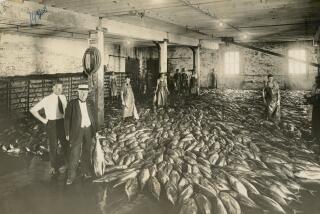Sharing Treasured Piece of the Past
- Share via
SANTA ANA — The telephone call from James Parten on a Friday last April at first didn’t seem to offer much in the way of a story.
Parten said he lived in Santa Ana and had some old photos of the Tustin Marine Corps Air Station. The base had been named that day as one of those targeted for closure, so his subject was timely. But Parten, 60, had never served there, never even really spent much time on the base.
But he had grown up near it and had watched the transformation it helped bring to sleepy, agricultural Orange County in the 1940s. And he’d saved a favorite photograph of the base--of its huge blimp hangars--for decades, and he wanted to let us have a copy.
Plus, we had a quiet Saturday without much news to cover. So I wandered over to Parten’s house, and we talked for more than an hour in his living room.
“I’ll hate to see it go,” Parten said of the base. “It’s a part of this county.”
A couple of minutes into our conversation, Parten unrolled a copy of his most prized photograph, a picture his father had gotten from the base when he worked there a half-century ago. Parten had saved it, carefully storing the picture on the top shelf of his closet and treasuring that piece of his--and the county’s--past.
He pointed to the faces of the young servicemen in the photograph, and they summoned up for him memories of the base in its early years, a military outpost welcomed by a grateful county that needed the work and wanted the protection.
Parten remembered his days as a fifth-grader roughhousing in the fields that once surrounded the base; he recalled watching wide-eyed as the military people went through their drills; he told of giggling excitedly in the dark as the social events brought together decked-out Navy men and their bobby-socked dates, who danced in the hangars to the music of the big bands.
And as he spoke, I realized that Parten was the kind of person I encounter all too infrequently in my reporting rounds. He was not a policy-maker; he’d never run for office, much less been elected.
Sure, he had a couple of ideas about how he’d run things--he thinks, for instance, that if they take away that air base, they ought to put a new county jail there--but he didn’t call looking for votes, and he wasn’t trying to get a project approved or a politician in trouble.
In fact, the story we ran about him that Sunday--on our front page--was the only time he’d ever been profiled by a newspaper.
But he had a modest story in him, and it told something about the county he grew up in--the one that I cover every day. I came away feeling I’d learned something that day about the people and history of this county.
What’s more, I came away reminded that news sometimes springs from the most unlikely sources: that you don’t have to be a county supervisor to know something about this area and its people.
And James Parten? Well, he snuck a little corner of the spotlight for a few days. Television stations invited him to tell his story to them, newspapers and magazines called asking him for interviews, military people sought him out, a museum or two even called.
“It was great there for a while,” Parten said last week. “I walked up the street or I’d go to the bank, and people would say: ‘Hey, Jim, you’re famous.’ ”
Some friends even suggested that he make a run for the City Council. He finds the idea flattering, but he’s not announcing any candidacies.
He accepted most of the other offers, though, happily sharing his tale and his photograph with almost anyone who asked.
Then, within a week or so, the attention moved on. And Parten took his photograph, rolled it up, and put it back in his closet.
“I just hope people listened,” he said. “I don’t want them to waste that base.”
More to Read
Sign up for Essential California
The most important California stories and recommendations in your inbox every morning.
You may occasionally receive promotional content from the Los Angeles Times.











